La Cosa Radiactiva has brought a group of young engineers, musicians & artists on the roads of Spain to explore sites related with radioactivity.
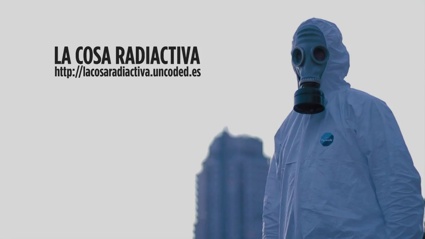
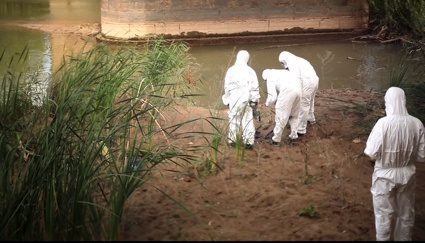
The team (composed of Sergio Galán, Victor Díaz, Alejandro Pérez, Servando Barreiro, Marcos Carnero, Alvaro Santamaría and Javier Villaroel) is not always welcome in nor around the facilities they investigated but they nevertheless measured radioactivity in locations that range from the Arrocampo artificial lake (which water is used to refrigerate the turbines of the nearby Almaraz Nuclear Power Plant) to a dismantled uranium mine in La Haba (a small town of 1000 inhabitants in the Badajoz province), from the first nuclear power plant (in process of dismantling) in Zorita to a nuclear waste storage facility in El Cabril (Córdoba), etc.
They traveled with their own measurement and visualization system that combines a Geiger counter, an Arduino microcontroller and an app for Android phones. The data gathered is visualized on online maps and in the form of audiovisual performances organized on the public squares of the villages and small towns they visit. The findings collected are also used to trigger discussions with the local population as well as with a broader audience about the social and cultural impact of nuclear energy.
La Cosa Radiactiva is a “research on transparency and nuclear secrets. A performance to demystify radiation while building awareness of its risks. An imagination exercise to reflect on how it would be like to live with radiation and above all this, a call about the importance of citizens having their own tools to be able to verify public health data provided by governmental authorities.”
La Cosa Radiactiva / The Radioactive Thing. English trailer
La Cosa Radiactiva / The Radioactive Thing is another brilliant project i discovered during my last visit to MediaLab Prado (i recently wrote about Citizen Cyber Science and the Freedom of Speech Kit.) Because i only had a few minutes to talk about it with Sergio Galán while i was in Madrid, i emailed him to ask him further questions about the project.
Hola Sergio! How much is known, made public in Spain about radioactivity? Was it easy for the team to find information about the location of radioactive sites?
First of all, just to clarify, all places we visited were not radioactive, I mean, with high levels of radioactivity. They were places with some connection with the nuclear industries: mines, factories, centrals, storages… Some of them are still working some are dismantled.
So, answering the question, it is not a secret to find those places. These are mostly old industrial places which are documented in quite a few webs.
Then in Spain there is an official network of radiation sensors which is online.
Also incidences are reported and listed, so it is not bad.
But it is tricky. For instance, the ambient sensors provide a measurement of “radiation” around them, so we might think that if those sensors are below certain levels there is no risk.
There is a Geiger counter in many places where old mines or nuclear power plants are. Even if there were a leak or there is underground contamination, the geiger counter won’t measure anything alarming unless something quite big is happening.
If you measure ambient radiation in a room where there is radioactively contaminated rice, you won’t see a high measurement in your geiger counter, but it doesn’t mean you can eat the rice. Counters detect external irradiation not contamination. If you don’t know this, sensors can provide a fake “safe” feeling.
Furthermore when something happens, transparency falls down. In Spain during the last 30 years we haven’t had a serious incidence, but even the small ones were hidden below the carpet. There was a tiny leak in ASCO – one of the nuclear power plants in Spain – and they didn’t inform about the incidence until months later.
So it is a strange policy, always showing off transparency but hiding information when something happens. This is an example that should make us think twice before being too optimistic about the current transparency & open data wave – which of course I stand for – because it can also be used as a smoke curtain to hide things while seeming transparent.
One of the objectives of La Cosa Radiactiva is to ‘hold workshops where people can learn about our work and about the radioactive phenomenon in a different way.” How different is it from the way radioactivity is presented in mainstream media?
Since it was discovered there has been a strong fascination for radioactivity, thinking about it as a kind of paranormal power like green waves emerging from minerals and mutating all life around. One of our goals when doing our workshops was to teach basic scientific knowledge. We explained that of course it might be dangerous but it is a natural phenomenon, governed by natural laws. And it is actually everywhere, it is on nature in low levels.
Reality is that a lot of people don’t have a serious clue about what radioactivity is. I’ve talked to many people about the project I was doing and quite a few asked me if it had to do with mobile phone waves, which is a totally different issue. So people don’t receive scientific education to differentiate electromagnetic waves from nuclear radiation, but we – as a democratic country or society – have decided that we can use it as one of our key energy sources
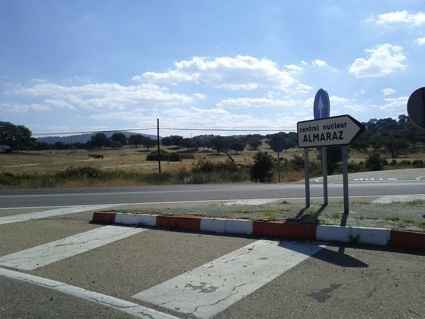 Photo La Cosa Radiactiva
Photo La Cosa Radiactiva
While on a tour to locate and measure radioactivity around Spain, you met with local communities. How aware (and maybe worried?) are they about the presence of radiation in their environment?
We didn’t make any serious poll, but my impression is that there is always a group of people interested and worried, but most of the people don’t really care. For instance in a village were there used to be an uranium factory (where most of the workers died or are suffering uranium related illnesses) a guy told us that people don’t talk about it. Some of them want to know if there is danger but at the same time they don’t want to dig too much, because in case of finding something it might create economic troubles to the region.
So in the places we visited, when there is a nuclear power plant, people live well, they have jobs and so on. And they don’t want to know. When there was something in the past, it is an old conflict. It is buried, only ecologists complain from time to time.
The exception is when there is an ongoing conflict. We visited a small village next to where the government plans to build a storage for nuclear waste and in that region people are really engaged, both for and against it.
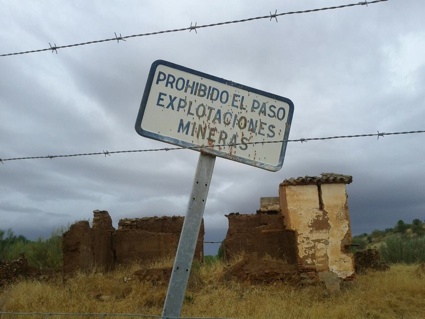 Photo La Cosa Radiactiva
Photo La Cosa Radiactiva
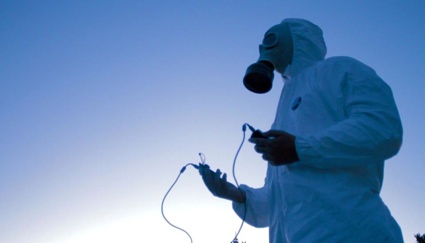 Photo La Cosa Radiactiva
Photo La Cosa Radiactiva
What is the state of the nuclear energy discourse is in Spain right now? Is the country planing to create new power stations or is it looking for other forms of energy?
It is very ambiguous. On one hand there is a “nuclear moratory”. Seven nuclear reactors were under construction in the 80’s and then the government stopped them (so they are now just huge empty cement buildings that we are still paying, which is another interesting topic).
On the other hand, the active nuclear power plants, easily get new permissions to keep working for more years. Current government is more pro-nuclear than the old one, but I don’t think they’ll seriously plan to build more nuclear power plants, basically because they are very expensive, and require many years to start producing energy. Public sector is not investing on anything right now, and private sector won’t invest unless they are strongly supported by public money/laws.
The official policy used to be to build more wind and sun powered plants -and Spain is actually among the leaders in both technologies. I think that it is the right thing, but is it enough? People like green energy and don’t like carbon or nuclear, but nobody asks the uncomfortable questions like: Can we sustain our energy appetite with green tech only? Are we willing to pay more money for energy to avoid the energy sources with bad reputation? Or are we willing to stop our continuous growth system to consume less energy?
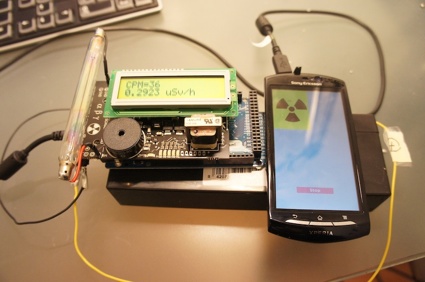 Can you describe briefly the DiY Geiger counters you’ve made and how members of the public will one day be able to make their own?
Can you describe briefly the DiY Geiger counters you’ve made and how members of the public will one day be able to make their own?
Since Fukushima’s accident there has been quite a lot of interest for domestic Geiger counters, so they are becoming cheaper and smaller. The one we bought is made by a Spanish company and it is fully open hardware. It works over Arduino, and using the “Android-ready” version of Arduino we could connect it to the mobile phone.
So we don’t build it but it is technically possible to build it from scratch. What we developed is a software to use the counter with Android phones. Thanks to the Medialab-Prado’s open lab I contacted Alvaro and together with my colleague Victor we did all the Android+Arduino coding.
The goal was to build something more “user centered”, a kind of nice interface for geiger counters so people can use it to make explorations and understand what’s going on and how good or bad the measurement is.
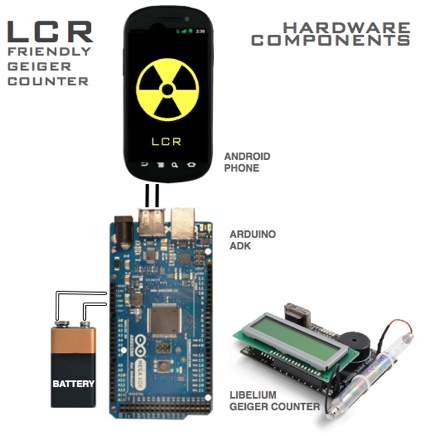 Does the device show the difference between natural and man-made radioactivity? Sorry for the idiot question but have both forms of radioactivity the same impact on the environment?
Does the device show the difference between natural and man-made radioactivity? Sorry for the idiot question but have both forms of radioactivity the same impact on the environment?
Please note that I’m talking as an amateur, not as a scientist, so I might be not very precise. But in essence there are three kinds of radioactive particles: Alpha Beta and Gamma. The three of them can be natural or man-made. A Geiger counter reads the total radiation level so we don’t know if the radioactivity we are measuring is natural or not. However if you read an abnormally high level of radiation somewhere, there is probably some human involved there.
Each radioactive element decays into other element emitting different combinations of particles, so scientific equipment can find out if the radiation is coming from natural sources or from other elements which are not usual in nature or directly only exist in nuclear waste or in the nuclear fusion process.
Animals are used to live with low levels of natural radiation in their environment, so if it suddenly increases that is when health problems start to appear.
La Cosa Radiactiva is also about transforming nuclear radiation into image & sound. Can you explain us how?
One of the main goals of the project was to work with radioactivity as a kind of input material for art or performances. So I contacted Servando Barreiro which is a media artist and VJ and also an old acquaintance. He had made a laser projector and with it he generates waves and shapes. For me, the aesthetic of his laser projections, resonates with what popular culture associates with radioactivity: green rays of death. So we agreed on working together. We added an option to the mobile app to stream the measurement levels. So Servando receives the measurement levels and he uses that information to change and modify the shapes of the projections.
My main idea was to have a kind of laser sculpture for villages with nuclear power plants. The laser sculpture will draw day after day the same bored calm shapes. But if there is a radiation leak and the village is in danger, the sculpture would mutate into creepy shapes, and people would admire it before realising that they are in danger.
It sounds poetic but we couldn’t talk with the mayor of any place interested on having this. So I just tell it as a kind of design fiction, and in case a mayor of a “radioactive town” wants to build it, he can contact us.
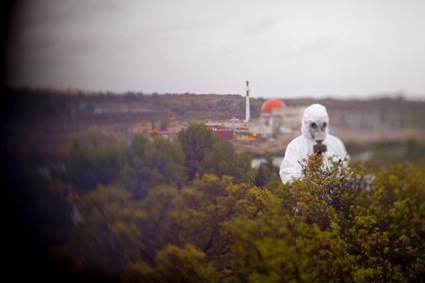 Is the project over or are you planning to work further on it?
Is the project over or are you planning to work further on it?
I’d love to have some time to finish the app adding a nice visualisation on how dangerous the radiation level that you are measuring is. That will happen probably soon. But the project as it was imagined at the beginning is almost finished. Now I’m thinking on what to do with this. We could make a nice installation for art centres and so on, but we’ll see. For now we’ve just released the documentary a couple of days ago. Marcos Carnero recorded our trip and together with Alejandro we made the script for a series of short films explaining the project and the opinions of the people we found.
For the future I’d like this to be a kind of public service. Like ghostbusters. People would send us an email telling: I think I saw green smoke coming out of the nuclear power plant yesterday. Can you explain us how the geiger counters works or can you come with your counters and tell us what’s going on? But besides accidents, I think the main utility for geiger counters is educational. Showing people how it works, explaining that radioactivity is everywhere and using them as a tool to learn & talk (and get fascinated by Servando’s figures if they have the chance to.)
Thanks Sergio!
More about the project on its website, blog, facebook page, in a series of short videos with english subtitles.
